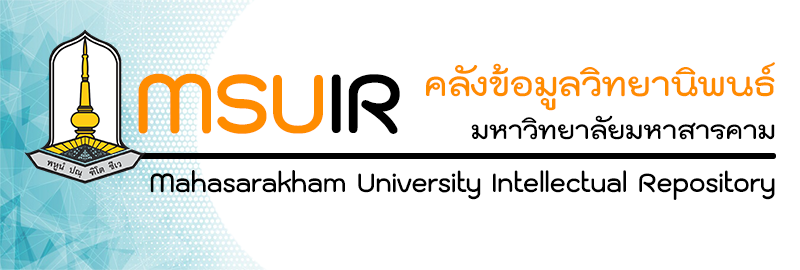Please use this identifier to cite or link to this item:
http://202.28.34.124/dspace/handle123456789/2668| Title: | Assessment of surface runoff in flash flood area การประเมินปริมาณน้ำท่าในพื้นที่น้ำท่วมฉับพลัน |
| Authors: | Lakkana Suwannachai ลักขณา สุวรรณชัย Anongrit Kangrang อนงค์ฤทธิ์ แข็งแรง Mahasarakham University Anongrit Kangrang อนงค์ฤทธิ์ แข็งแรง anongrit.k@msu.ac.th anongrit.k@msu.ac.th |
| Keywords: | น้ำท่วมฉับพลัน การเปลี่ยนแปลงการใช้ประโยชน์ที่ดิน ปริมาณน้ำฝน แบบจำลอง SWAT แบบจำลอง HEC-RAS Flash Flood Land use change Rainfall SWAT HEC-RAS |
| Issue Date: | 18 |
| Publisher: | Mahasarakham University |
| Abstract: | This study focuses on the severe and impactful issue of flooding on life, the economy, and the environment. The research utilizes data modeling with the SWAT and HEC-RAS frameworks to assess and analyze factors contributing to sudden onset flooding. Additionally, it aims to develop strategies for future flood control and prevention. The results from the SWAT and HEC-RAS simulations, based on metrics such as R2, RMSE, NSE, and PBIAS, conform to accepted standards. The analysis reveals continuous increases in flooded areas in all three watersheds from 2006 to 2019. A significant driver of this issue is the land use change from forests to agricultural areas. The rate of increase in flooded areas varies across different watersheds, with a 0.92% increase in the Lam Saphung River Basin, 5.50% in the Phrom River Basin, and 2.5% in the Chern River Basin Part 1. In summary, this research emphasizes the relationship between expanding flooded areas and land use changes. It identifies forested watersheds and those converted to agriculture as the highest-risk areas for flooding. Flood risk varies among the watersheds and their H1 and H3 risk levels. Therefore, appropriate management strategies and forest preservation are crucial for mitigating flood risks in the future. การศึกษานี้เน้นการปัญหาของน้ำท่วมที่รุนแรงและกระทบมากต่อชีวิต เศรษฐกิจ และสิ่งแวดล้อม การวิจัยนี้ใช้การจำลองข้อมูลด้วยโครงสร้าง SWAT และ HEC-RAS เพื่อประเมินและวิเคราะห์ปัจจัยที่มีผลต่อน้ำท่วมฉับพลัน พร้อมกับการสร้างกลยุทธ์ในการควบคุมและป้องกันน้ำท่วมในอนาคต ผลลัพธ์จากการจำลองของ SWAT และ HEC-RAS ตามค่าวัดความสอดคล้องเช่น R2, RMSE, NSE, และ PBIAS ที่ตรงตามมาตรฐานที่ยอมรับ การวิเคราะห์การเปลี่ยนแปลงในการใช้ที่ดินและปริมาณฝนแสดงให้เห็นถึงการเพิ่มพื้นที่ที่น้ำท่วมต่อเนื่องในลุ่มน้ำทั้ง 3 ตั้งแต่ ปี 2549 ถึง 2562 การเปลี่ยนแปลงการใช้ที่ดินจากป่าเป็นพื้นที่เกษตรกรรมเป็นเหตุผลสำคัญของปัญหานี้ การเพิ่มพื้นที่ที่น้ำท่วมมีอัตราการเพิ่มต่างกันในลุ่มน้ำต่างๆ คือ 0.92% ในลุ่มน้ำลำสะพุง 5.50% ในลุ่มน้ำพรม และ 2.5% ในลุ่มน้ำลำเชิญส่วนที่ 1 โดยผลสรุป การวิจัยเน้นความสัมพันธ์ระหว่างการเพิ่มพื้นที่ที่น้ำท่วมและการเปลี่ยนแปลงการใช้ที่ดิน และชี้ว่าลุ่มน้ำที่เป็นป่าและลุ่มน้ำที่ใช้ที่ดินเพาะปลูกเกษตรกรรมเป็นพื้นที่ที่ที่มีความเสี่ยงสูงสุดในการเกิดน้ำท่วม ความเสี่ยงของน้ำท่วมมีค่าต่างกันในลุ่มน้ำแต่ละลุ่มและตำแหน่งความเสี่ยงด้วยระดับ H1 และ H3 ดังนั้น การจัดการด้วยกลยุทธ์ที่เหมาะสมและการอนุรักษ์ป่าเป็นสิ่งสำคัญในการลดความเสี่ยงน้ำท่วมในอนาคต |
| URI: | http://202.28.34.124/dspace/handle123456789/2668 |
| Appears in Collections: | The Faculty of Engineering |
Files in This Item:
| File | Description | Size | Format | |
|---|---|---|---|---|
| 62010391003.pdf | 6.56 MB | Adobe PDF | View/Open |
Items in DSpace are protected by copyright, with all rights reserved, unless otherwise indicated.

